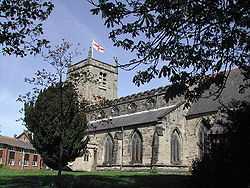St. Mary's Church, Arnold
Coordinates: 53°00′33″N 01°07′37″W / 53.00917°N 1.12694°W
| St. Mary’s Church, Arnold | |
|---|---|
 | |
| Denomination | Church of England |
| Churchmanship | Broad Church |
| Website | stmarysarnold.org.uk |
| History | |
| Dedication | St. Mary |
| Administration | |
| Parish | Arnold, Nottinghamshire |
| Diocese | Southwell and Nottingham |
| Province | York |
| Clergy | |
| Vicar(s) | Revd Kenneth Shill |
| Curate(s) | Revd Jane Blatherwick |
| Laity | |
| Organist/Director of music | Ian Rosillo |
St. Mary’s Church is a parish church in the Church of England in Arnold, Nottingham. Though there is no official founding date, it is estimated that the church dates back to 1176.[1]
The church is Grade II* listed by the Department for Culture, Media & Sport as a result of receiving significant attention from tourists.[2]
History

The church is medieval but was restored in 1868 to 1869 by Scott.[3] There was further restoration in 1877 under the direction of Richard Charles Sutton.[4] The structure or property is also “listed under the Planning (Listed Buildings and Conservation Areas) Act 1990 as amended for its special architectural or historic interest.”[2] St. Mary's Church “may lie within the boundary of more than one authority,” which further supports its historic significance, based in the fact that certain records and so much interest has kept the Church intact, well visited, restored, and written or recorded about; known authorities include, but are not limited to, Nottinghamshire County and Gedling District.[2]
The church contains the remains of an Easter Sepulchre.[2]
Bells
There are eight bells in the Tower, the largest of which is the Tenor weighing over 8 cwt. The Tenor is also the newest bell, cast by Taylors Eayre & Smith Ltd on 20 April 2006 and installed by Pembleton's on 28 April 2007. The Tenor was dedicated by the Rt. Rev. Tony Porter, Bishop of Sherwood, on 3 June 2007.
Churchyard graves and memorials
The oldest decipherable and dated inscription in the Churchyard can be found on a small stone ten yards south of the Church and close to the tomb of the Stanfields.
It reads as follows:
“1690, Near this place lyeth ye Body of John, Son of Sam Leadbeater by Mary his Wife, who departed this life Novm. ye 14th. Rebecca Elley was one of the benefactors of the Free School; she died 27 December 1785, aged 70.”
There are some very old stones of this family, which has been located in Arnold for more than 300 years.
Daft – One member of this family was founder of the firm of Daft & Jessop, Drapers, Long Row, Nottingham.
Rev. G. F. Holcombe, died 24 August 1872, aged 84 years.
Rev. M. J. Truman, died 2 December 1906, aged 65 years. Adjoining Mr. Truman's grave is the grave of Emma Burwell Truman, his first wife.
William Morris, died 1234, aged 13; was apparently landlord of the Three Crowns Inn at Red Hill. The concluding lines of
his epitaph read as follows: “Three Crowns on Earth adorn’d my Name, One Crown immortal now I claim.”
John Worrall, died 1898, aged 88, was a well-known builder and farmer; for many years he collected the Taxes.
John Simpson, of Arnot Hill, died 1853, aged 67, was a man of some note.
Thomas Robinson, died 1664, aged 77. His first wife, Alice, died 1839, aged 34, is also interred here; these were the parents of Sir John Robinson, of Worksop Manor, and Mr. Samuel Robinson. Mr. Thomas Robinson's second wife, Ann, died 1879, aged 74, and is also interred with other members of the family in this, the family burying-ground.
Acton – The burying ground of the Acton family, ancestors and relatives of Mr. James Acton, of Goodwood House, was a carefully kept plot just inside the gate of the north Churchyard. Thomas Sheldon, died 1875, aged 80; he fought at Waterloo.
The families of Redgate, Sturtevant, Settles, Need, Oscroft, Frost, Morris, Moore, Rhodes, Newham, Stanfield, Surgey, Dickinson, Simkin, Clay, Williamson, Blatherwick, Bryan, Phipps, Leverton, Alvey, Atherley, Lee, Gill, Truman, Askew, Hearson, Dove, Smedley, Wilkinson, Dean, Skerritt, Barrow, Jones, Challand, Shelton, Allcock, Jeffrey, Bacon, Bradbury, Ward, Holbrook, Pembleton, Jackson, Gadsby, Parr, Howitt, Kelk, Burton, Bradley, Mellors, Marshall, Wood, Garratt, Lamin, Stones, Hart, Clarke, Chadburn, Simpson, Holt, Jew, Worton, Extall, Showell, George, Kendall, Stretch, Robinson, Acton, Mann, Godfrey, Prior, Hartshorn, Peck, and Willows, are among the many families whose ancestors are represented in the inscriptions.
Mr. John Atherley was the last of the musicians who played instruments in the old gallery of Arnold Church. He was interred April 29, 1915, aged 75.
The Churchyard was enlarged around 1851. At the Consecration, a young man named John Toplis was present; and when the ceremony was over he exclaimed, “I wonder what poor devil will be buried there first.” Soon after reaching home, he was became afflicted with smallpox and died after three days.[5]
Sources
| Wikimedia Commons has media related to St Mary’s Church, Arnold. |
- ↑ "History". St. Mary's Church, Arnold. Retrieved 22 February 2014.
- ↑ 2.0 2.1 2.2 2.3 Historic England. "CHURCH OF ST MARY (1235987)". National Heritage List for England.
- ↑ Pevsner, Nikolaus. 1979. The Buildings of England:Nottinghamshire. page 257. Harmondsworth, Middx. Penguin.
- ↑ Nottinghamshire Guardian – Friday 23 February 1877
- ↑ Mellors, Robert (1913). King, R W; Russell, J, eds. A History of Arnold. p. 70. Retrieved 23 March 2015.